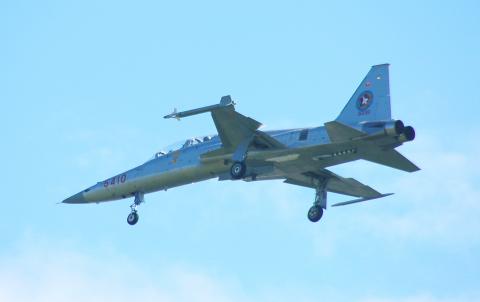Witnesses last night said they saw what appeared to be two air force aircraft crash into mountains near the 116km section of the Suhua Highway on Taiwan’s east coast.
Following the report, the Ministry of Defense sent a search and rescue team to the area.
“We were fishing at the seaside when suddenly airplanes flew over our heads, and a moment later we heard a loud bang and the whole mountain was set on fire. The explosion was very loud,” one witness said.

Photo: Huang Ming-tang, Taipei Times
The witnesses said that while the planes looked like military aircraft, they could not be sure.
The fire brigade dispatched fire engines to the area as soon as the incident was reported.
Ministry of Defense spokesman Colonel David Lo (羅紹和) confirmed that an F-5F fighter and an RF-5 reconnaissance plane had taken off from the air force base in Hualien at 7:39pm for a nighttime training flight, but had disappeared from radar screens at 7:52pm. Lo identified the pilot of the RF-5 as Captain Hsiao Wen-min (蕭文民) and the crew of the F-5F as Lieutenant Colonel Chang Chien-kuo (常建國) and Major Wang Hung-hsiang (王鴻祥).
At press time, a search and rescue team was at the scene, but there was no news yet about the crew.
Taiwan’s aging F-5s are scheduled for retirement and will be replaced by F-16C/Ds, if the US agrees to the sale.

Seventy percent of middle and elementary schools now conduct English classes entirely in English, the Ministry of Education said, as it encourages schools nationwide to adopt this practice Minister of Education (MOE) Cheng Ying-yao (鄭英耀) is scheduled to present a report on the government’s bilingual education policy to the Legislative Yuan’s Education and Culture Committee today. The report would outline strategies aimed at expanding access to education, reducing regional disparities and improving talent cultivation. Implementation of bilingual education policies has varied across local governments, occasionally drawing public criticism. For example, some schools have required teachers of non-English subjects to pass English proficiency

‘FORM OF PROTEST’: The German Institute Taipei said it was ‘shocked’ to see Nazi symbolism used in connection with political aims as it condemned the incident Sung Chien-liang (宋建樑), who led efforts to recall Democratic Progressive Party (DPP) Legislator Lee Kun-cheng (李坤城), was released on bail of NT$80,000 yesterday amid an outcry over a Nazi armband he wore to questioning the night before. Sung arrived at the New Taipei City District Prosecutors’ Office for questioning in a recall petition forgery case on Tuesday night wearing a red armband bearing a swastika, carrying a copy of Adolf Hitler’s Mein Kampf and giving a Nazi salute. Sung left the building at 1:15am without the armband and apparently covering the book with a coat. This is a serious international scandal and Chinese

TRADE: The premier pledged safeguards on ‘Made in Taiwan’ labeling, anti-dumping measures and stricter export controls to strengthen its position in trade talks Products labeled “made in Taiwan” must be genuinely made in Taiwan, Premier Cho Jung-tai (卓榮泰) said yesterday, vowing to enforce strict safeguards against “origin laundering” and initiate anti-dumping investigations to prevent China dumping its products in Taiwan. Cho made the remarks in a discussion session with representatives from industries in Kaohsiung. In response to the US government’s recent announcement of “reciprocal” tariffs on its trading partners, President William Lai (賴清德) and Cho last week began a series of consultations with industry leaders nationwide to gather feedback and address concerns. Taiwanese and US officials held a videoconference on Friday evening to discuss the

PERSONAL DATA: The implicated KMT members allegedly compiled their petitions by copying names from party lists without the consent of the people concerned Judicial authorities searched six locations yesterday and questioned six people, including one elderly Chinese Nationalist Party (KMT) member and five KMT Youth League associates, about alleged signature forgery and fraud relating to their recall efforts against two Democratic Progressive Party (DPP) legislators. After launching a probe into alleged signature forgery and related fraud in the KMT’s recall effort, prosecutors received a number of complaints, including about one petition that had 1,748 signatures of voters whose family members said they had already passed away, and also voters who said they did not approve the use of their name, Taipei Deputy Chief Prosecutor